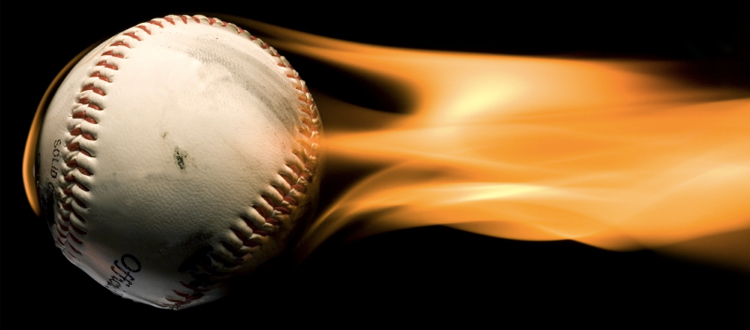Teaching The Fastball
How to Grip a Four Seam Fastball
I think the best grip for velocity and control on the fastball is across the 4 seams grip. The ball is balanced and consistent finger pressure allows for good control and this grip imparts the fastest ball rotation.
- The ball is gripped across the wide seams with the finger pads over the seams.
- Normally the fingers should be 1/2 to 3/4 of an inch apart. To improve control, widen out slightly.
- The thumb is placed directly under the ball and the ball rests on the inside bony surface of the first joint in the thumb.
- The ring finger is flexed into the palm with only the inside of the second knuckle touching and stabilizing the ball.
- The ball is held out in the fingers and does not contact the fleshy part of the palm. There should be a good space between the first finger and the thumb.
- The grip should be firm, but the wrist and forearm muscles should be loose and relaxed.
- For good control, the grip, finger pressure and release point must be consistent.
The Mechanics of Throwing a Four Seam Fastball
- The palm of the hand faces the plate with the first two fingers on top of and directly behind the ball.
- The ball comes out of the hand as the wrist flexes forward to a neutral position and the hand crosses a line about even with the pitchers face.
- Upon release, the fingers flex forward following the ball and the wrist will naturally pop forward.
- The ball should come off the finger pad of the outer half of the middle finger. This will give the ball some side, as well as backward rotation causing the ball to move.
- The arm continues downward across and outside the lead leg for a good long smooth arc of deceleration.
How to Grip a Two Seam Fastball
The second most popular grip is the two seam. This grip decreases ball rotation which increases air resistance, which creates more movement and causes the ball to sink. Most pitchers will lose 1-2 mph off their best fastball. Also, because the ball is unbalanced and moves more, the pitch is more difficult to control. If a pitcher has the potential for good velocity, we prefer the four seam grip.
- One of the best grips for the sinker-ball is to hold the ball with two fingers close together inside the point where the seams narrow.
- The grip will have slightly firmer finger pressure, and the ball held a little deeper in the hand than a 4 seamer.
- The ball should be slightly unbalanced by off centering the ball toward the ring finger and applying more pressure to the first finger pad.
- Thumb position – two methods:
- The thumb is under the ball resting on a seam on the inside bony surface of the 1st joint. Upon release, the thumb is slightly pulled under the ball, creating a side to over-spin.
- For pitchers with large hands and long fingers, some prefer to flex the thumb back under the ball more to get the ball down and over the thumb quicker.
The mechanics of throwing a two seam fastball
- As the arm and hand come to the release point, the wrist is slightly turned outward.
- There is little more first finger pressure as the fingers come over and down through the inside of the ball.
- The thumb pulls outward slightly and under the ball. Remember the ball is already off centered a little to the ring finger.
- The wrist is flexed down and outward slightly. The wrist will not be as loose as on a normal fast ball.
Fastball Variables
With the fastball, we look for three basic things: control, velocity, and movement, but without control, the latter two skills are not very effective.
1. Fastball control:
An effective pitcher must be able to throw his fastball to predetermined spots and not just for strikes. Unless a pitcher is really overpowering, just to throw the fastball in the strike zone is not enough to get good hitters out. The best way to develop control of a pitch is to have an effective and consistent grip, a consistent release point, plus great visual and mental concentration.
2. Fastball velocity:
There are very few truly overpowering fast ball pitchers and most have a natural, not learned ability. I do believe a coach can help a pitcher improve his velocity somewhat by improving his mechanics, arm action, weight transfer and increasing his strength and stamina with a year round program.
3. Fastball movement:
An effective pitcher’s fast ball will move int a right handed hitter from a RHP. Proper grip, finger pressure, loose wrist and proper release will give the ball fast rotation and movement. A live fastball is much more difficult to it than a straight fast ball because the hitter has to judge two planes instead of one.
Learning Different Pitches
Remember this: Even though this site describes a method of throwing five or six different pitches, it does not mean any pitcher should attempt to learn or throw all these pitches.
High school and college pitchers should try to master just three pitches. Even many major league pitchers are successful with three basic pitches. Some may add a specialty or fourth pitch as they get more experienced.
Youth pitchers 14 and under should concentrate on developing the fastball and learning to throw it to spots, plus learning to change speeds on the pitch.
Pitchers who haven’t reached puberty should not throw breaking pitches competitively due to their lack of muscle, ligament and bone development. The breaking pitches create more stress on the elbow joint and bicep in young pitchers may not be developed enough to properly decelerate the forearm.


